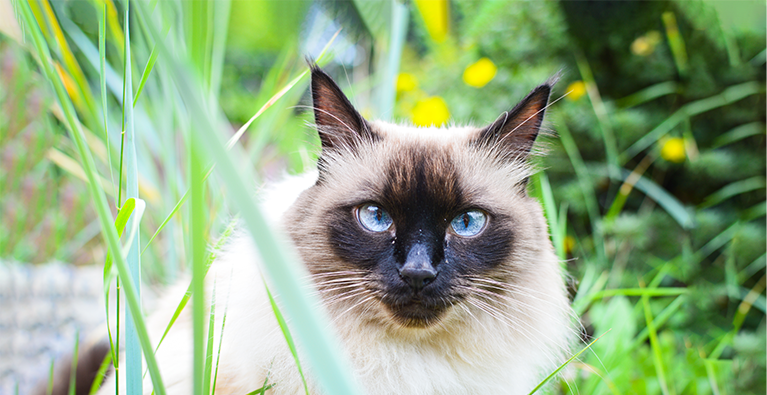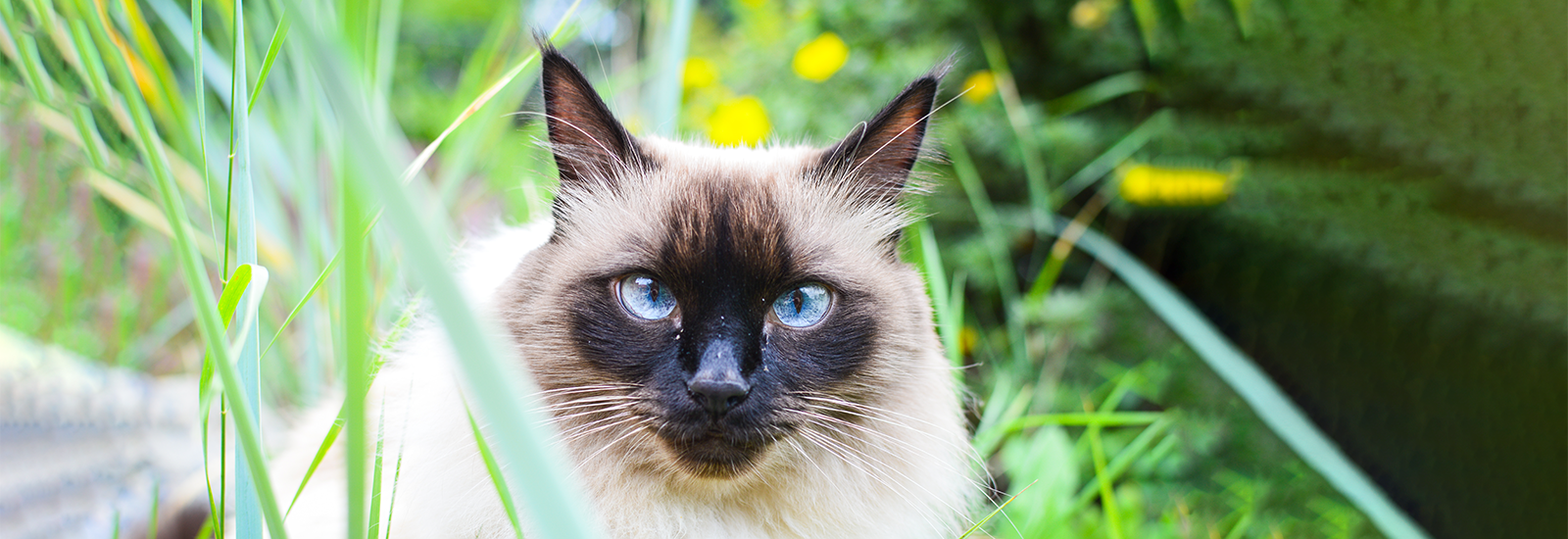Balinese cat
The Balinese cat is a long-haired variant of the Siamese cat. The two breeds share a high level of intelligence and curiosity. In addition, the Balinese is known for its talkativeness and lively nature.
Profile of the Balinese cat
- Size medium
- Weight female: approx. 3.5 kg, male: approx. 4.5 kg
- Origin Thailand
- Build elongated body, slender
- Length of fur medium-long
- Colour of fur light with “points”
- Grooming medium
- Behaviour talkative, appetite for adventure
- Character intelligent, inquisitive
Appearance and character of Balinese cats
If you like the appearance of Siamese cats but would prefer a cuddly long-haired version instead of a shorthaired cat, you are in luck: the Balinese is descended from the Siamese cat and has almost exactly the same breed standard. The only difference is the length of the fur. The Balinese has a medium-long coat and a bushy tail. The fur is fine, silky and has hardly any undercoat. The basic colour is whitish, and all kittens are born like this. However, after a few months, the “points” slowly begin to emerge. These are coloured areas on the head, ears, paws and tail. They can be cream, fawn, cinnamon, seal, red, blue or chocolate.
The Balinese cat is medium-sized, slender, elegant and sleek. Its head is slightly wedge-shaped and it has big pointed ears. Not only its points, but also its deep blue eyes are particularly striking.
One thing is for sure: life will never be boring with a Balinese cat. This breed takes an active part in the lives of its humans. It is very sociable and talkative, and likes it when there is plenty of activity in its home. It therefore has no problem with children, unless they tease or taunt it. It loves playing games, and is intelligent and willing to learn tricks. When it has had the chance to work off its energy, it will have no objection to a cuddling session with its human.
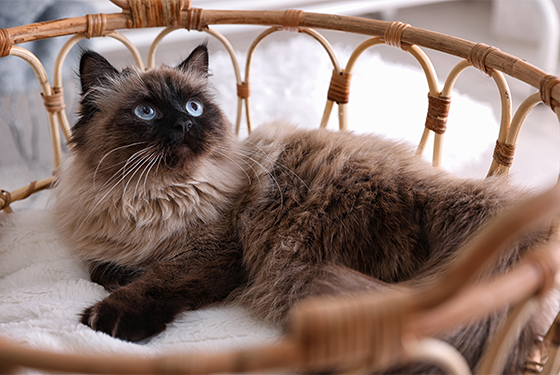
Keeping and caring for a Balinese cat
Balinese cats enjoy company, so they are not suited to being the only cat in the household or spending extended periods of time alone. It is ideal if you have two of them, because they are then less likely to suffer from boredom. But even then, it is important that you spend plenty of time with your furry friends. They adore playing, whether it’s with a cat fishing rod, intelligence toys or balls. Some even like to retrieve objects. If they have plenty of things to keep them occupied indoors, they will not need to go outside; they will, however, also be happy to have access to a cat-proof balcony or garden.
Although the Balinese is a breed of cat with medium-length fur, it is fortunate that it has hardly any undercoat. The fur is therefore less likely to become matted. The Balinese cat also moults less than is the case with cats that have an undercoat. They do, however, still shed quite a lot of fur, which is why it is advisable to regularly comb or brush your pet – not only during moulting. It is usually sufficient to do this once a week. When it is moulting, you should increase the frequency to ensure that your cat swallows less hair when it cleans itself.
Nutrition
Whether it’s a kitten, an adult cat or a senior – the food for a Balinese cat should always be of high quality and tailored to its age. Cats are carnivores by nature, so cat food should always contain a high proportion of meaty ingredients. Sugar, flavour enhancers and artificial colourings and preservatives do not belong in the food.
animonda has the ideal food for every stage of your cat’s life. You can choose between kitten, adult and senior cat food. The products are specially formulated to meet the specific nutritional requirements of the different life stages of cats. This provides the best foundation for your pet to enjoy a long and healthy life.
Balinese cat: health
Balinese cats have a life expectancy of 15 to 20 years. This shows that it is basically a very healthy breed. Sadly, the gene pool is very limited due to the small number of animals. This may be linked to the increased incidence of hereditary diseases.
In order to produce healthy pets, responsible breeders always have genetic tests carried out on their cats and exclude any with health issues from breeding. Make sure that you find a reputable breeder who is able to document their commitment with health certificates.
Despite good preventive healthcare, illnesses can occur. In the case of the Balinese cat, these include hypertrophic cardiomyopathy (HCM). This is a heart disease that leads to a thickening of the muscular wall of the heart. The cat can also suffer from gangliosidosis. This is a storage disease that causes disorders of the brain. The symptoms include head tremors and restricted mobility.
History and breeding
The name of this breed suggests that it originates from the island of Bali, but this is incorrect. Like the Siamese, Balinese cats actually have their origins in Thailand. They have been kept at the royal court and in temples for centuries. The Siamese is a short-haired cat, but occasionally you will find long-haired kittens in a litter. This was also the case when, in the 19th century, animals were occasionally exported to Great Britain and the United States. The breeders showed no interest in these cats, because they did not comply with the breed standard. The long-haired cats were simply sold to cat lovers who had no interest in breeding.
It is not known how it came about that kittens with long fur occasionally appeared in litters. This may have been due to a Persian cat or another long-haired cat being deliberately or accidentally bred in. It may also be the result of a spontaneous mutation.
After years of hardly anyone showing any interest in them, Marion Dorsey began breeding purebred Balinese cats in California in the 1950s. At first they were known as ‘long-haired Siamese cats’, but to avoid any confusion, it was decided to change the name. Balinese dancers with their grace and elegance were the inspiration for the name Balinese cat. The breed was officially recognised in the USA, and in 1983 the European governing body FIFe followed suit. Sadly, it never achieved widespread popularity, which is why the Balinese is still a rare breed that is quite difficult to get hold of.
You may also like this
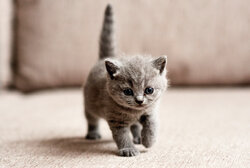
Feeding kitten - nutrition tips
What small kittens need for healthy development
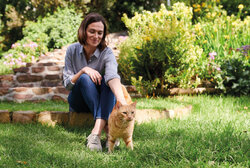
God cat food
How to recognize good cat food for your darling

A kitten is moving in
Tips for collection, initial equipment and settling in
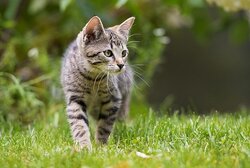
Getting your cat used to being outdoors
Hot to get your cat used to going outside
